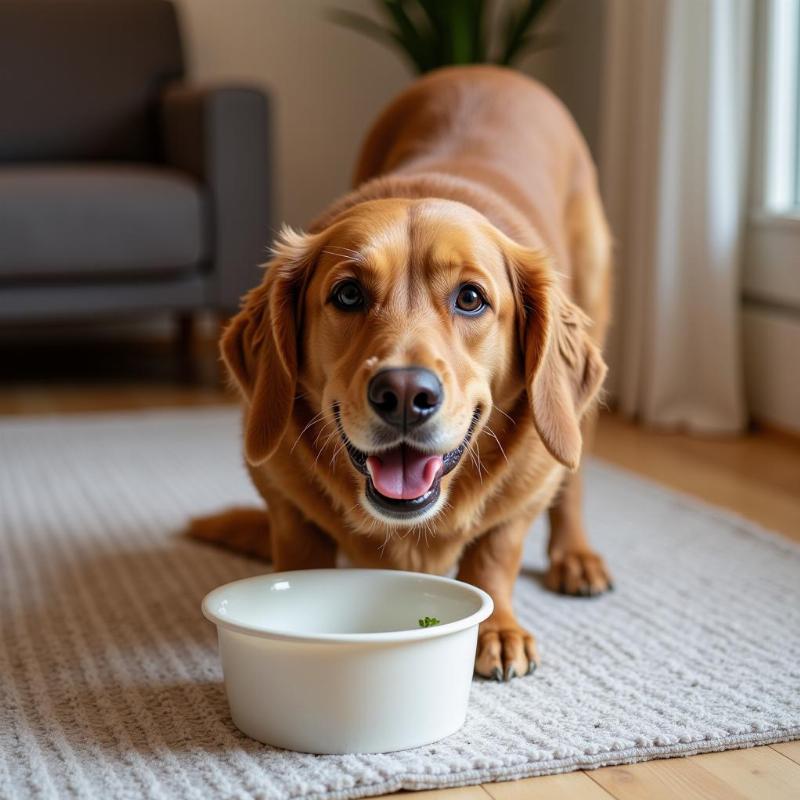Keeping your dog out of the cat food can feel like a constant battle. After all, that tempting, high-protein kibble smells delicious to canine noses! This article will explore practical and effective strategies to prevent your dog from raiding your cat’s food bowl, ensuring a peaceful and healthy multi-pet household. We’ll cover everything from understanding the reasons behind this behavior to implementing training techniques and environmental adjustments. Let’s delve into how you can finally achieve harmony at mealtimes.
Understanding Why Dogs Love Cat Food
Cat food is formulated to meet the specific nutritional needs of felines, which differ significantly from those of canines. It’s typically higher in protein and fat, making it incredibly enticing for dogs. This difference in nutritional composition can lead to digestive upset, obesity, and even pancreatitis in dogs if they consume cat food regularly. Beyond the appealing aroma and taste, some dogs might be driven by boredom, hunger, or even a simple opportunistic streak. Understanding your dog’s motivation is crucial for selecting the most effective deterrent strategies.
Effective Strategies to Keep Dogs Away From Cat Food
There are several proven methods to stop your dog from indulging in forbidden feline feasts. These range from simple environmental adjustments to training techniques that require a bit more patience and consistency.
Environmental Management
- Elevated Food Bowls: Placing your cat’s food bowl on a higher surface, such as a cat tree, shelf, or a specifically designed elevated feeder, can make it inaccessible to your dog while still allowing your cat easy access.
- Feeding in Separate Rooms: The most straightforward solution is often the most effective. Feed your pets in separate rooms, closing the door to prevent your dog from entering the cat’s dining area.
- Automatic Feeders: Consider investing in an automatic cat feeder that opens only for your cat, perhaps triggered by a microchip. This ensures your cat has access to food while keeping it securely away from your dog.
- Baby Gates: Utilize baby gates to create a barrier between your dog and the cat’s food. Choose a gate tall enough that your dog can’t jump over it.
Training Techniques
- “Leave It” Command: Training your dog to reliably respond to the “leave it” command is invaluable. This command can be used in various situations, including preventing them from approaching the cat’s food. Start by practicing with less tempting treats and gradually work your way up to the cat food.
- Consistent Reinforcement: Consistency is key to success. Every time your dog attempts to eat the cat food, redirect their attention and reward them for leaving it alone.
- Create a Designated Feeding Area for Your Dog: Ensure your dog has their own designated feeding area where they receive regular meals and treats. This can help reduce their motivation to seek out alternative food sources.
 Dog eating its own food
Dog eating its own food
Choosing the Right Strategy for Your Pets
The most effective strategy will depend on your individual pets’ personalities and your living situation. If your dog is particularly persistent, a combination of environmental management and training techniques might be necessary. If you’re unsure which method is best, consult with a professional dog trainer or veterinarian for personalized guidance.
Conclusion
Keeping your dog out of the cat food is essential for the health and well-being of both pets. By understanding the motivations behind this behavior and implementing the strategies outlined in this article, you can create a peaceful mealtime environment for everyone. Remember, consistency and patience are crucial for success. With a little effort, you can finally put an end to the cat food raids and foster a harmonious multi-pet household. Don’t let the battle of the bowls continue!
FAQ
- Is cat food harmful to dogs? Yes, regular consumption of cat food can lead to digestive issues, obesity, and pancreatitis in dogs.
- What if my dog continues to steal cat food despite my efforts? Consult with a professional dog trainer or veterinarian for personalized advice.
- Can I use punishment to stop my dog from eating cat food? Punishment is generally ineffective and can damage your relationship with your dog. Positive reinforcement methods are much more successful.
- Are automatic feeders a good solution for all dogs? While often effective, some dogs may become frustrated or try to break into the feeder. Observe your dog’s reaction carefully.
- How long will it take to train my dog to “leave it”? The time it takes to train a dog varies, but with consistency and patience, you should see progress within a few weeks.
- What if my cat starts eating the dog’s food? This is less common but can still occur. Similar strategies, such as elevated bowls or separate feeding areas, can be applied.
- Is it okay to let my dog have a little bit of cat food occasionally? No, it’s best to avoid allowing your dog to develop a taste for cat food altogether.
Boost your dog’s summer appetite with our delicious recipes! Check out: do dogs eat less in the summer
Looking for comfortable and stylish dog kennels? Find the best kennels in your area: dog kennels in summerville sc
Give your furry friend a cool summer treat! Check out our delightful selection: stick dog dreams of ice cream
Beautdogs.us is your premier online resource for all things dog-related in the United States. We offer expert advice on dog breeds, care, and product recommendations, catering to both novice and experienced dog owners. From finding the right ice cream running dog denim shorts for a stylish summer stroll, to planning your next BBQ with catering hot dogs and hamburgers, Beautdogs.us has you covered. Connect with us today for tailored support and expert guidance! Email: [email protected], Phone: +1 501-555-7529. Visit Beautdogs.us for more information.